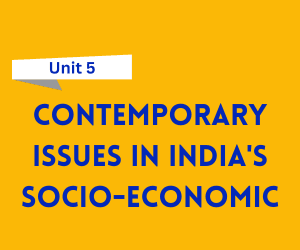India, as a rapidly developing nation, faces a range of pressing economic and social challenges. This unit explores the current macroeconomic concerns, environmental issues, infrastructure gaps, and key welfare initiatives undertaken by the government. For BBA students, understanding these issues is vital to developing informed perspectives on policy and business decisions in the Indian context.

Download Unit 5 – Current Economic and Social Issues Notes Notes
Get simplified revision notes for this unit:
⬇️
Download Unit 5 Notes PDF
Inflation, Fiscal Deficit, and Monetary Policy
Inflation:
Inflation refers to the general rise in prices of goods and services over time. Moderate inflation reflects a growing economy, but excessive inflation reduces purchasing power and hurts savings. India experiences demand-pull and cost-push inflation, driven by food prices, fuel costs, and global supply chain disruptions.
Fiscal Deficit:
The fiscal deficit arises when the government’s total expenditure exceeds its total revenue (excluding borrowings). A high fiscal deficit indicates borrowing dependency, leading to interest burdens and crowding out private investment. India has targeted reducing its deficit through increased tax revenue and better expenditure control.
Monetary Policy:
Monetary policy is managed by the Reserve Bank of India (RBI). The central bank adjusts repo rates, reverse repo, CRR, and SLR to control inflation and ensure liquidity in the economy. In times of economic slowdown, the RBI adopts an accommodative stance to stimulate growth.
Environmental Concerns and Sustainable Development
1. Environmental Issues:
Rapid industrialization, urbanization, and population growth have led to serious environmental degradation in India. Air pollution in cities like Delhi, water pollution in rivers, deforestation, and improper waste disposal are critical challenges.
2. Sustainable Development:
Sustainable development aims to meet the needs of the present without compromising the future. India is focusing on renewable energy (solar, wind), afforestation, clean energy transitions, and carbon neutrality goals. The government has launched programs like National Solar Mission and Swachh Bharat Abhiyan to promote sustainability.
Social Infrastructure: Education, Health, and Housing
1. Education:
A robust education system is key to economic progress. India has made strides in literacy and higher education, but still faces challenges in quality, access, and digital infrastructure. Initiatives like NEP 2020 and Skill India Mission aim to bridge gaps.
2. Health:
The healthcare sector suffers from low public spending, infrastructure shortages, and urban-rural divides. However, schemes like Ayushman Bharat aim to provide financial protection and access to quality health services for all.
3. Housing:
Affordable and safe housing remains a concern, especially in urban slums. Programs like Pradhan Mantri Awas Yojana (PMAY) seek to ensure “Housing for All” by 2024, with subsidies and incentives for low-income groups.
Government Welfare Programs
MGNREGA (Mahatma Gandhi National Rural Employment Guarantee Act):
Provides 100 days of guaranteed wage employment in rural areas. It promotes livelihood security and rural asset creation.
Jan Dhan Yojana:
Aims at financial inclusion by ensuring every household has access to banking facilities, with zero balance accounts, direct benefit transfers, and insurance coverage.
Ayushman Bharat:
One of the world’s largest health assurance schemes, providing coverage of ₹5 lakh per family per year for secondary and tertiary healthcare.
